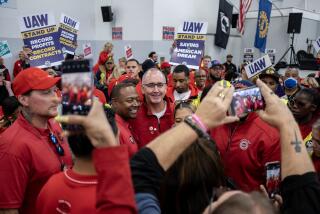Japanese Workers Go Extra Mile to Ensure Cars’ Quality
OPPAMA, Japan — The banners were hung throughout Nissan’s sprawling assembly plant here, urging workers to attain a goal that many did not even understand at first:
“First in Rogers!” the banners said in Japanese.
The hidden meaning behind that slogan: All Nissan workers must join as a team to build the best cars in the world.
Nissan’s executives figured that if one of their cars could be ranked first in the Rogers Report, a little-known quality newsletter put out by an Ohio research firm, then Nissan could also win top honors in the more prestigious--and more widely publicized--quality surveys by J. D. Power & Associates, an Agoura Hills automotive market research firm.
“We felt that if we won Rogers, then we would win Power, too,” said Nissan engineer Masayoshi Horike. “But we had to make some videos to explain what the banners meant to the workers.”
Such exhortations to pull together as a team may sound corny to Americans, but in Japan they really work: Once they understood the banners, the Oppama workers went on to help make the Nissan Maxima first in Rogers and first in J. D. Power in 1989.
Now, more than a decade after the Japanese first became a major force in the American car market, Detroit has still failed to catch up on quality.
One key reason is that the Japanese still get their workers to do the little things better. They have maintained an obsessive attention to detail that results in what industry experts call a better “fit and finish” to their cars.
Doors do not rattle. Sheet metal panels line up straight on car bodies. Brand-new cars do not have to go back to the dealership to fix annoyingly defective light switches or turn signals.
The Japanese call such workmanship issues “taken-for-granted quality”--doing the things right that customers expect and demand that you do right.
“I believe the Americans have caught up in some areas, but I think the gap is still great in this ‘taken-for-granted’ area,” observed Katsuyoshi Yamada, general manager of quality control at Toyota.
To be sure, much of the credit for Japanese automotive quality must go to their superior design and engineering processes; the Japanese themselves talk constantly about the need to “design in” quality before a car ever reaches the factory floor.
Yet the genuine sense of teamwork among factory workers here at Oppama and elsewhere in Japan has clearly played a critical role in helping the Japanese maintain their lead in quality throughout the 1980s.
Workers are willing to pay attention to details when they really feel that they are part of a team, and the Japanese auto companies still do a much better job of that than do the Big Three.
American executives, of course, have talked teamwork almost to death throughout the 1980s.
But the Japanese really live it, and that makes all the difference when it comes to exhorting people in a factory to pay attention to details and build quality products.
Ironically, the Japanese maintain this sense of teamwork between management and labor even though their society is rigidly hierarchical; the Japanese obsession with exchanging business cards is part of a subtle effort to determine who ranks higher and who should bow the lowest.
But while status and power vary widely in Japan, pay does not. There is a much smaller salary differential between boss and employee in Japan than in the United States, and the absence of an American-style economic gulf between the executive suite and the shop floor seems to be one reason that factory workers in Japan believe that management’s commitment to teamwork is genuine.
For example, a bucho, or general manager, at Toyota--one of the top officials in the largest company in Japan--makes only about $120,000 including bonus, less than half what a comparable executive would make in Detroit, American auto industry officials acknowledge.
Meanwhile, at the current exchange rate, the average Toyota assembly-line worker makes nearly $23 per hour, or roughly $49,000 a year, counting bonuses and overtime. In fact, with overtime and extra pay for night work, it is even possible for a foreman at Toyota to make more than a mid-career engineer, according to Toyota spokesman Kanji Sugamoto.
Japan’s pay parity even extends to the company chairman and president.
Most chief executives of major Japanese auto companies make $350,000 to $450,000 a year, roughly 10 times what their factory workers earn. By contrast, the chief executives of American auto companies can make $2 million or more, including bonuses and stock options, about 50 times as much as their workers. In some years, that ratio has skyrocketed to as much as 500 times more. But Japanese executives do not get those glittering perks, such as stock options, that have proliferated throughout American industry, inflating executive pay in Detroit and across the nation. Such ostentatious compensation is considered tactless in Japan. Several Japanese auto companies have recently bought helicopters to ferry their executives above Tokyo’s massive traffic jams, but at least a few reportedly hesitated for fear of appearing too showy.
In fact, only a handful of the very highest auto executives are given free cars--which flow like water to every middle manager in Detroit. “I don’t get a free car,” acknowledged Tadahiko Fukuyama, a senior manager in charge of Nissan’s international public affairs operations. “I just get a 10% discount.”
But it is Toyota that, more than most Japanese firms, goes to extreme lengths to make sure that its workers do not feel that management is taking advantage of them.
For instance, there is no carpeting on the floors in Toyota’s vast engineering offices in Toyota City, the company’s headquarters town in central Japan.
Because there is no carpeting along its assembly lines, Toyota decided that its engineers shouldn’t have any, either. That’s so that when factory workers are brought in to discuss new projects with the engineers, they will not think that Toyota is treating its engineers any better than its workers on the shop floor.
“There is a kind of corporate socialism here,” noted John Shook, who in the early 1980s became the first American to work for Toyota in Toyota City. “And so the sense of teamwork is genuine. The workers believe it.”
But the Japanese have had more trouble instilling that spirit of teamwork in their workers at their new American factories, a troubling omen for an industry that is shifting more and more production from Japan to the United States.
Discontent has raged this year both at Mazda’s Michigan assembly plant and at Nissan’s Tennessee factory, as workers have complained that Japanese labor policies aimed at “constant improvement” are actually being abused to allow management to increase line speeds and eliminate jobs.
But virtually all of the workers’ complaints have been with the way their American supervisors manipulate the Japanese labor system, and not with the system itself.
“In America, the differences between blue collar and white collar are still very strong,” noted Horike of Nissan. “It isn’t so here.”






